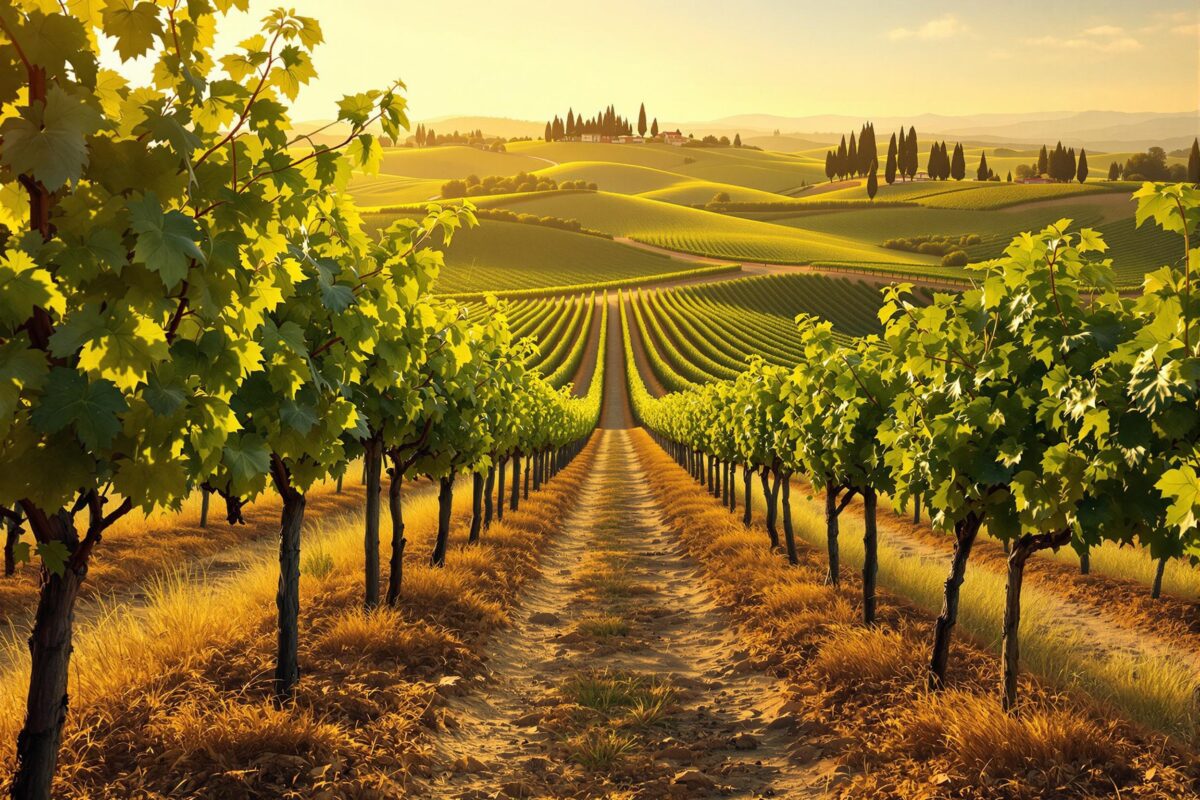Tuscany: Picture rolling hills, iconic cypress trees, and a winemaking heritage unlike any other. This Italian region is synonymous with premium red wines, and at its heart lies Sangiovese—the noble grape defining Tuscan viticulture and contributing significantly to Italy’s global wine prestige. Over half of Tuscany’s wine production focuses on red wines, with Sangiovese leading the charge. Join us as we explore the captivating legacy of Sangiovese, focusing on the esteemed Chianti Classico, and unravel the intricate tapestry of Tuscan winemaking.
Discovering the Rich Legacy of Sangiovese
Sangiovese is the lifeblood of Tuscan wines, its history intertwined with the region’s terroir. This traditional grape has thrived for centuries, shaping Tuscany’s cultural and economic landscape. Imagine Sangiovese gracing Tuscan hillsides since Roman times, solidifying its presence during the medieval era. This grape’s adaptability to diverse Tuscan environments and its ability to yield wines of remarkable character have cemented its status as the region’s flagship variety. More than just a beverage, Sangiovese wines embody Tuscan heritage—a testament to centuries of viticultural expertise and a deep connection to the land.
Cultural Deep Dive: Chianti Classico’s Influence
Chianti Classico, arguably the most iconic Sangiovese wine, embodies a historical and modern influence deeply woven into Tuscan culture. The Chianti region, centered around Chianti Classico, boasts centuries of wine production. Formal regulations have evolved to protect and elevate Chianti Classico’s quality. Historically, Chianti Classico often involved a blend of grapes, including white varieties. Modern regulations now emphasize Sangiovese’s dominance, stipulating minimum percentages and permitted blending grapes. This shift towards Sangiovese purity highlights a broader Tuscan movement towards terroir-driven wines. The black rooster, “Gallo Nero,” proudly adorns Chianti Classico bottles, a symbol of the Chianti Classico Consortium, guaranteeing authenticity and adherence to rigorous standards. Chianti Classico’s modern influence spans the globe, its wines recognized as benchmarks for premium Italian reds. The enduring appeal? Balancing tradition with innovation, creating Sangiovese wines both historically rooted and relevant to modern palates.
Terroir Tales: Tuscany’s Geography and Its Wines
Tuscany’s unique geography—rolling hills, varied altitudes, and diverse soil compositions—profoundly shapes its wines, especially those made from Sangiovese. Terroir—the interplay of environmental factors influencing a wine’s character—plays a crucial role in Tuscan viticulture. The Apennine Mountains create diverse microclimates, impacting rainfall, temperature, and sunlight. Altitude variations lead to distinct ripening conditions; higher elevations experience cooler temperatures, resulting in higher acidity and aromatic complexity in Sangiovese. From the stony galestro and alberese soils of Chianti Classico to the clay and limestone of Brunello di Montalcino, each soil type imparts unique characteristics to the Sangiovese grape. The coastal influence adds another layer, with sea breezes moderating ripening in areas closer to the Tyrrhenian Sea. Tuscan terroir-driven wines are a direct reflection of this geographical diversity.
Shaping the Future: Trends in Tuscan Viticulture
Tuscan viticulture is a dynamic field, constantly evolving to embrace sustainable practices, adapt to global preferences, and incorporate innovation. Sustainability is paramount, with wineries adopting eco-friendly practices. Demand for eco-certified Tuscan wines is rising, reflecting a global shift towards environmentally conscious choices. Organic farming, biodynamic practices, and integrated pest management are just a few examples of sustainable approaches. While Chianti Classico and Brunello di Montalcino remain dominant, emerging regions like Valdarno di Sopra are gaining recognition for their high-quality Sangiovese. These regions often boast unique microclimates and soil compositions, further diversifying Tuscan wines. While Sangiovese remains the cornerstone, some producers experiment with international varieties like Syrah or Merlot, catering to evolving tastes. However, the focus remains on showcasing Sangiovese’s unique character, even in blends. Brunello di Montalcino, crafted from 100% Sangiovese Grosso, exemplifies this commitment, with its minimum four-year aging requirement.
Interactive Insights: Visualizing Tuscany’s Wine Regions
Visual maps of Tuscany’s wine regions offer interactive insights into the distribution of Sangiovese wines and their signature flavors. Exploring maps of Chianti Classico and Brunello di Montalcino reveals the intricate relationships between terroir, appellations, and wine styles. Maps highlighting soil types, altitude, and climate zones within Chianti Classico can illustrate the nuances and sub-regional variations. Similarly, maps of Brunello di Montalcino can pinpoint vineyards and showcase the influence of specific slopes and soil profiles. Interactive maps can also overlay information on signature flavors. For example, Chianti Classico often features notes of cherry, leather, and herbs, while Brunello di Montalcino exhibits richer fruit profiles like blackberry and plum, alongside earthy and spice notes.
Actionable Adventures: Experiencing Tuscan Wines
Wine tasting in Tuscany offers unparalleled opportunities to experience the region’s heritage. Visiting vineyards provides an immersive journey into winemaking, from vine to bottle. Many wineries offer tours and tastings, allowing you to explore vineyards and cellars. Chianti Classico and Brunello di Montalcino are home to numerous renowned vineyards. Wine pairing tips enhance the enjoyment of Tuscan wines. Sangiovese’s vibrant acidity and complex flavors make it remarkably versatile. Chianti Classico pairs well with classic Tuscan cuisine like pasta with ragu, grilled meats, and aged cheeses. Brunello di Montalcino, with its structure, complements richer dishes. Expert tastings offer invaluable guidance in exploring Sangiovese’s nuances. Sommeliers and wine experts can provide insights into vintage variations, terroir expressions, and aging potential. Wine tourism significantly contributes to Tuscany’s economy, with a post-COVID rebound of 15% annually.
Sangiovese stands as the quintessential expression of Tuscany, embodying a rich legacy, terroir-driven character, and a dynamic future. From Chianti Classico to Brunello di Montalcino, Tuscan viticulture continues to produce world-renowned wines. Sustainable practices, emerging regions, and global preferences shape Tuscany’s winemaking trajectory, ensuring its continued excellence.
